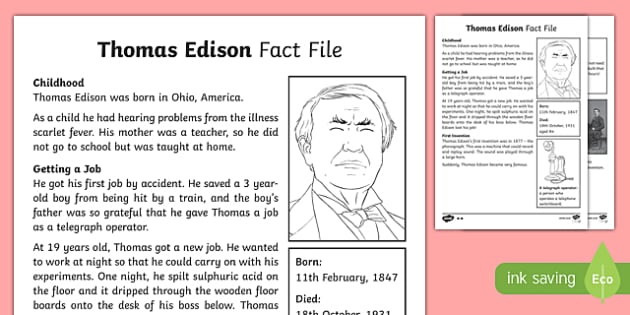

As a child, Edison built things and loved to experiment.His mother then home-schooled him, teaching Thomas to read and write. Thomas Edison attending formal school for less than one year.In 1854 when Edison was 7, his family moved to Port Huron, Michigan.Three of his siblings died during childhood. Thomas Edison was the 7th (and youngest) child in the family.Thomas Alva Edison was born on Februin Milan, Ohio.Thomas Edison Birthplace Museum, Milan, Ohio." (Jan. "Thomas Edison" and "Samuel O'Reilly." (Jan. "Thomas Edison's Concrete Houses." American Heritage. "Timeline: History of the Electric Car." Now on PBS. "When Edison tried to make single-pour concrete houses happen." Slate. New York University Department of Media, Culture and Communication."Edison now making concrete furniture." Dec. "Thomas Edison and his spirit phone." (Jan. "7 epic fails brought to you by the genius mind of Thomas Edison." Smithsonian Magazine. "Thomas Edison and the myth of the lone inventor." Slate. "Edison's forgotten 'invention.'" General Electric. "15 inventions from Thomas Edison that changed the world." Business Insider. Gilbert Wright was present and worked on the machine until his own death in 1959, but, as far as we know, never used it to contact spirits.Īquino, Judith and Sterbenz, Christina. Later, at another séance, Edison supposedly suggested some improvements. The machine was reportedly then built, but did not work. Some people claimed that at a séance in 1941, Edison's spirit told the participants that three of his assistants possessed the plans. Many people believe he was just playing a joke on the reporters he'd talked to about his "spirit phone." The inventor, himself an agnostic who admitted he had no idea if a spirit world even existed, spoke of his quest in several magazines and explained to The New York Times that his machine would measure what he described as the life units that scatter through the universe after death.Įdison corresponded with British inventor Sir William Crookes, who claimed to have captured images on "spirit photographs." These photos allegedly encouraged Edison, but he never introduced any machine that he said could communicate with the dead, and after his own death in 1931, no machine was found. In the aftermath of World War I, spiritualism was undergoing a revival, and many people hoped science could provide a means to access the souls of the recently deceased. Taking the idea of the telephone and the telegraph a bit further, Edison announced in October of 1920 that he was working on a machine to open the lines of communication with the spirit world. Suspicions are that the cabinets didn't survive the trip. The cabinets were to be unveiled in New York City at the annual cement industry show, but Edison didn't show up, and the cabinets weren't heard of again. They shipped the phonograph cabinets around the country as a publicity stunt, and Edison affixed stickers on the packaging, asking the shippers to please handle them roughly. In 1911, Edison's company molded a piano, bathtub and cabinets that could house Edison's phonographs. He claimed he could furnish an entire house for less than $200. Made with air-impregnated foam to keep the weight at only one-and-a-half times that of wooden furniture, Edison's line of concrete furnishings would be sanded and smoothed into a mirror-like finish or stained to look like wood grain.

Edison 5 facts full#
Why should a young couple go into debt to purchase furniture that will last only a few decades? Edison proposed that for half the money, they could obtain a house full of concrete furniture that would endure for eternity. "Yes" and "no" wheels kept track of the vote totals and tabulated the results. The current would cause the chemicals in the paper to dissolve on the side for which the vote should be recorded. After voting was completed, the clerk would place a chemically treated piece of paper on top of the metal type and run a metal roller over it. At the desk, the names of the legislators were embedded in metal type in two columns - "yes" and "no." Legislators would move a switch on the device to point to either "yes" or "no," sending an electric current to the device at the clerk's desk. In Edison's vote-recorder, a voting device was connected to the clerk's desk. Congress, to record their votes in a more timely fashion than the time-honored voice vote system. He was one of several inventors at the time developing methods for legislative bodies, such as the U.S. Edison was a 22-year-old telegraph operator when he received his first patent for a machine he called the electrographic vote-recorder.


 0 kommentar(er)
0 kommentar(er)
